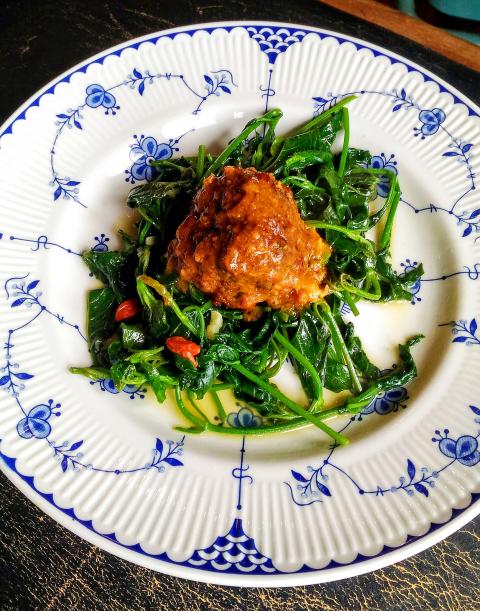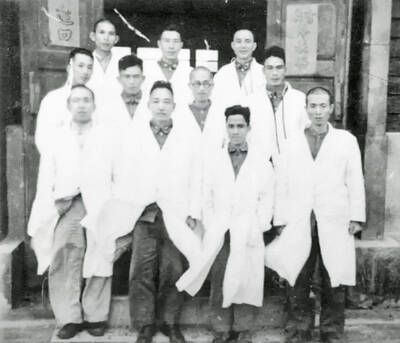Goji berries have had their time in the limelight, featuring as a superfood on recent Western menus, though they have long been an integral part of Chinese medicinal lore and are often used in “tonic” dishes, particularly soups. Often ignored are the leaves of this plant, which are remarkably nondescript in appearance but which many culinary and pharmacological commentators regard as nearly as good as the berry in terms of the benefits they bestow.
I first came across goji leaves by accident, mistaking them for sweet potato leaves not so much due to their appearance, but simply due to the casual way they were presented in the market stall, strewn across a tarpaulin to be easily scooped up an armfuls. Because of their incredible cheapness, goji leaves are not accorded much ceremony.
This is the sort of vegetable I warm to ideologically, but often these so called “wild greens” don’t taste so great on the dinner plate. I have tried quite a range of such greens and written about a couple, and while they definitely afford a source of nutrition and often considerable health benefits, their uses are often limited to one or two specialty dishes that are notable more for cultural interest than gastronomic excitation.

Photo: Ian Bartholomew
Goji is also called Chinese wolfberry, and is part of the nightshade family that includes culinary heroes such as potatoes and tomatoes, but also poisonous plants such as belladonna. A few years ago, goji shot from obscurity in the Western world to something that everyone was talking about for its amazing health-giving properties. This celebrity status has started to wane, along with the buzz around superfoods generally, as science continues to show that no amount of superfood will make up for a balanced diet of regular, non-super food that is conscientiously cultivated. It should also be said at the onset that there is little scientific support for many of the claims made for goji berries. That said, while the belief that they are able to induce perpetual youth and stop cancer in its tracks may be overblown, there is little doubt that they are a healthy part of anyone’s diet.
The leaves of this perennial have been all but forgotten, but in the hot summer days when locally grown greens are hard to come by, goji leaves prove to be surprisingly versatile. Tossing a bunch in the pan with a few lightly beaten eggs produces a very flavorful omelet that is delicious with just a little soy served over white rice. They can also be cooked until soft, and in Taiwanese cuisine they are probably most often seen in soups where their bitterness is mitigated by the liquid. It is often part of pig’s liver soup, the ultimate Chinese tonic soup prescribed by grandmothers for every ailment known to mankind.
Don’t be put off by the rather pedestrian appearance of goji leaves and work past the initial flavor of bitterness in the raw leaves, as goji leaves are one of those “wild greens” whose taste is relatively accessible, particularly if care is taken to pair it with other complementary flavors. In fact, the leaves and the berries make an excellent pairing, as the berries have a unique sweetness that mixes well with the complex flavor of the leaves. While the leaves are most often found in the budget section of a traditional market (I can get enough for two family meals for under NT$20), and the berries are mostly found in more upscale groceries or Chinese medicine stores, when fruit and leaf are brought back together in the kitchen, it is definitely a tasty reunion.

Photo: Ian Bartholomew
Lamb meatballs with tomato sauce and goji leaves
(Serves 2)
Goji leaves can be eaten simply fried with a bit of garlic and stock, but they do have a slightly bitter taste that can be off-putting for some. This bitterness works to its advantage when paired with rich meat such as lamb, helping to cut through the oil and balance the flavor. This fusion of Middle Eastern style lamb with Far Eastern vegetables might be pushing fusion into confusion, but the mix has proved successful in our family. Since both the meatballs and sauce can be frozen, you can bring this dish from the freezer onto the table within an hour with very little active preparation required. Adding the goji berries to the leaves provides additional color and a hint of sweetness that is quite appealing.
Ingredients
For the meatballs:
500g minced lamb
2 tsp cumin seeds
2 tbsp coriander seed
1 big pinch of salt
1 tsp black pepper
1 chili, seeds and ribs removed, minced
50g fine breadcrumbs
4 garlic cloves, crushed
juice of one lemon
1 egg
bunch of mint leaves, roughly chopped
For the tomato sauce:
(this makes plenty of sauce, ideal for freezing and topping on anything from pasta or thickening soup)
1kg tomatoes
1 tsp each of salt, black pepper and sugar
1 brown onion
1 carrot
1 clove garlic
olive oil
600ml vegetable stock
For the goji leaves:
1 bunch goji leaves
1 tbsp of dried goji berries (optional)
2 cloves garlic
salt and white pepper to season
1/4 cup vegetable stock
Directions:
1. Mix all the ingredients for the meatballs together, preferably using your hands, digging into the mixture and churning it so that all the ingredients mix together thoroughly. You can feel that the mixture is right when the meat has a smooth consistency to it, making the hands much superior to spoons or spatulas.
2. Shape into golf ball sized meatballs. These can be frozen and keep well in the freezer for up to a month.
3. Cut the tomatoes in half and place in a baking tray. Sprinkle with salt, pepper and sugar then drizzle generously with olive oil. Place in an oven pre-heated to 200c and roast for 1 hour.
4. Roughly chop the onion, carrot and garlic and cook over low heat in a large pot until soft. Add the roasted tomatoes and stock to the pot then bring to a boil. Turn down heat to low, cover pot and cook for 25 minutes.
5. Allow to cool. Once cool enough to handle safely, blitz the mixture into a thick puree in a blender. This mixture can be frozen for up to two weeks.
6. Put the meatballs in an oven-proof sautee pan with some oil and brown over as much of the surface as possible, about 15 minutes over medium heat. Remove meatballs and pour off excess oil.
7. Add the tomato sauce to the saute pan and bring to a simmer, stirring vigorously with a wooden spoon to loosen any of the tasty bits that stick to the base of the pan during the browning process.
8. Add the meatballs to the sauce, coating them lightly before putting them in a pre-heated oven at 180c for 40 minutes.
9. Just before the meatballs are done, heat some oil in a skillet. Throw in the garlic and fry until fragrant then add the goji leaves. Season with salt and white pepper, then add some stock and the dried goji berries
10. Stir over medium heat for another minute then remove from heat.
11. Place the goji leaves on a plate and scoop the meatballs and now thickened sauce over the top.
Ian Bartholomew runs Ian’s Table, a small guesthouse in Hualien. He has lived in Taiwan for many years writing about the food scene and has decided that until you look at farming, you know nothing about the food you eat. He can be contacted at Hualien202@gmail.com.

That US assistance was a model for Taiwan’s spectacular development success was early recognized by policymakers and analysts. In a report to the US Congress for the fiscal year 1962, former President John F. Kennedy noted Taiwan’s “rapid economic growth,” was “producing a substantial net gain in living.” Kennedy had a stake in Taiwan’s achievements and the US’ official development assistance (ODA) in general: In September 1961, his entreaty to make the 1960s a “decade of development,” and an accompanying proposal for dedicated legislation to this end, had been formalized by congressional passage of the Foreign Assistance Act. Two

Despite the intense sunshine, we were hardly breaking a sweat as we cruised along the flat, dedicated bike lane, well protected from the heat by a canopy of trees. The electric assist on the bikes likely made a difference, too. Far removed from the bustle and noise of the Taichung traffic, we admired the serene rural scenery, making our way over rivers, alongside rice paddies and through pear orchards. Our route for the day covered two bike paths that connect in Fengyuan District (豐原) and are best done together. The Hou-Feng Bike Path (后豐鐵馬道) runs southward from Houli District (后里) while the

March 31 to April 6 On May 13, 1950, National Taiwan University Hospital otolaryngologist Su You-peng (蘇友鵬) was summoned to the director’s office. He thought someone had complained about him practicing the violin at night, but when he entered the room, he knew something was terribly wrong. He saw several burly men who appeared to be government secret agents, and three other resident doctors: internist Hsu Chiang (許強), dermatologist Hu Pao-chen (胡寶珍) and ophthalmologist Hu Hsin-lin (胡鑫麟). They were handcuffed, herded onto two jeeps and taken to the Secrecy Bureau (保密局) for questioning. Su was still in his doctor’s robes at

Mirror mirror on the wall, what’s the fairest Disney live-action remake of them all? Wait, mirror. Hold on a second. Maybe choosing from the likes of Alice in Wonderland (2010), Mulan (2020) and The Lion King (2019) isn’t such a good idea. Mirror, on second thought, what’s on Netflix? Even the most devoted fans would have to acknowledge that these have not been the most illustrious illustrations of Disney magic. At their best (Pete’s Dragon? Cinderella?) they breathe life into old classics that could use a little updating. At their worst, well, blue Will Smith. Given the rapacious rate of remakes in modern